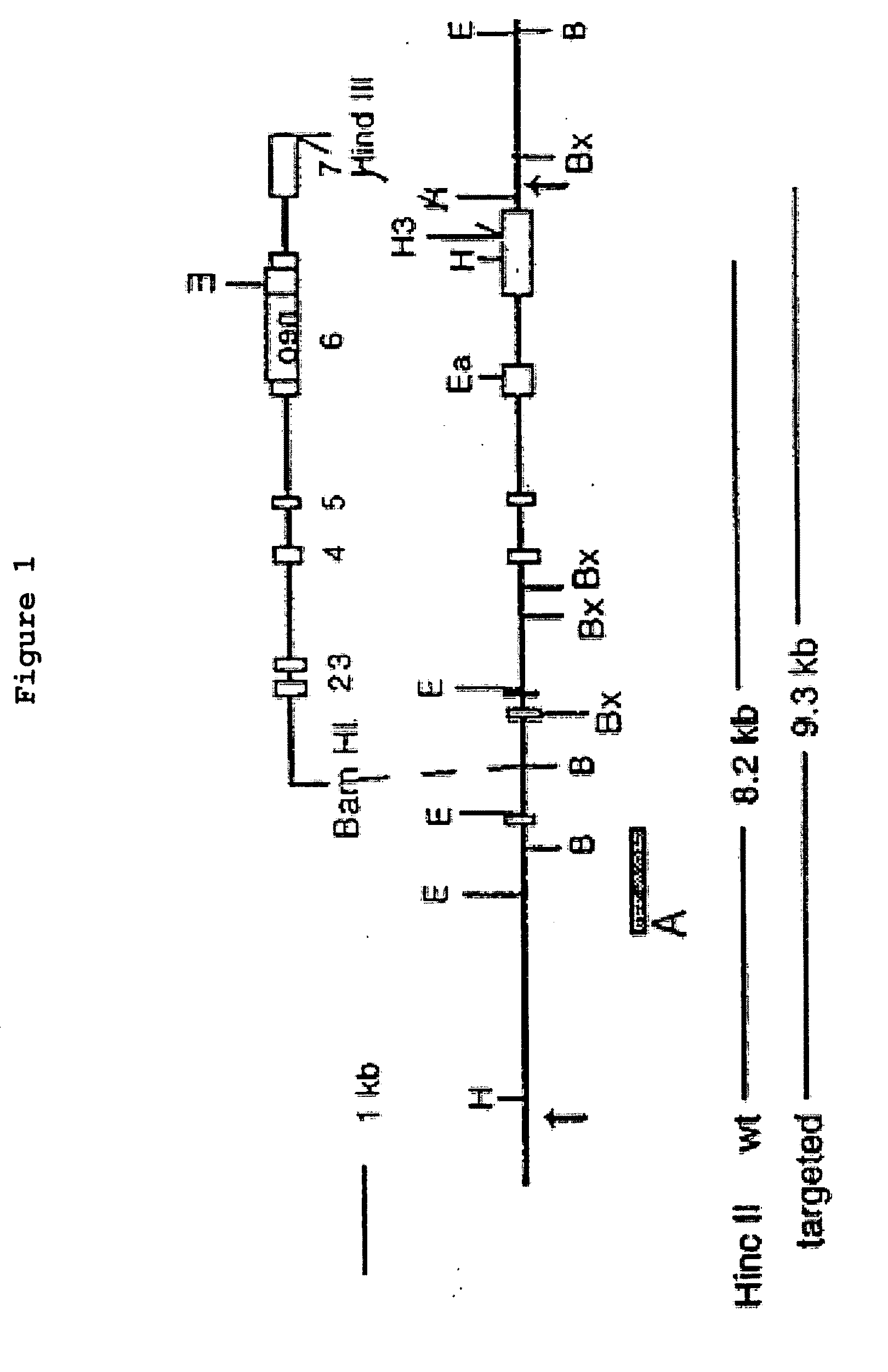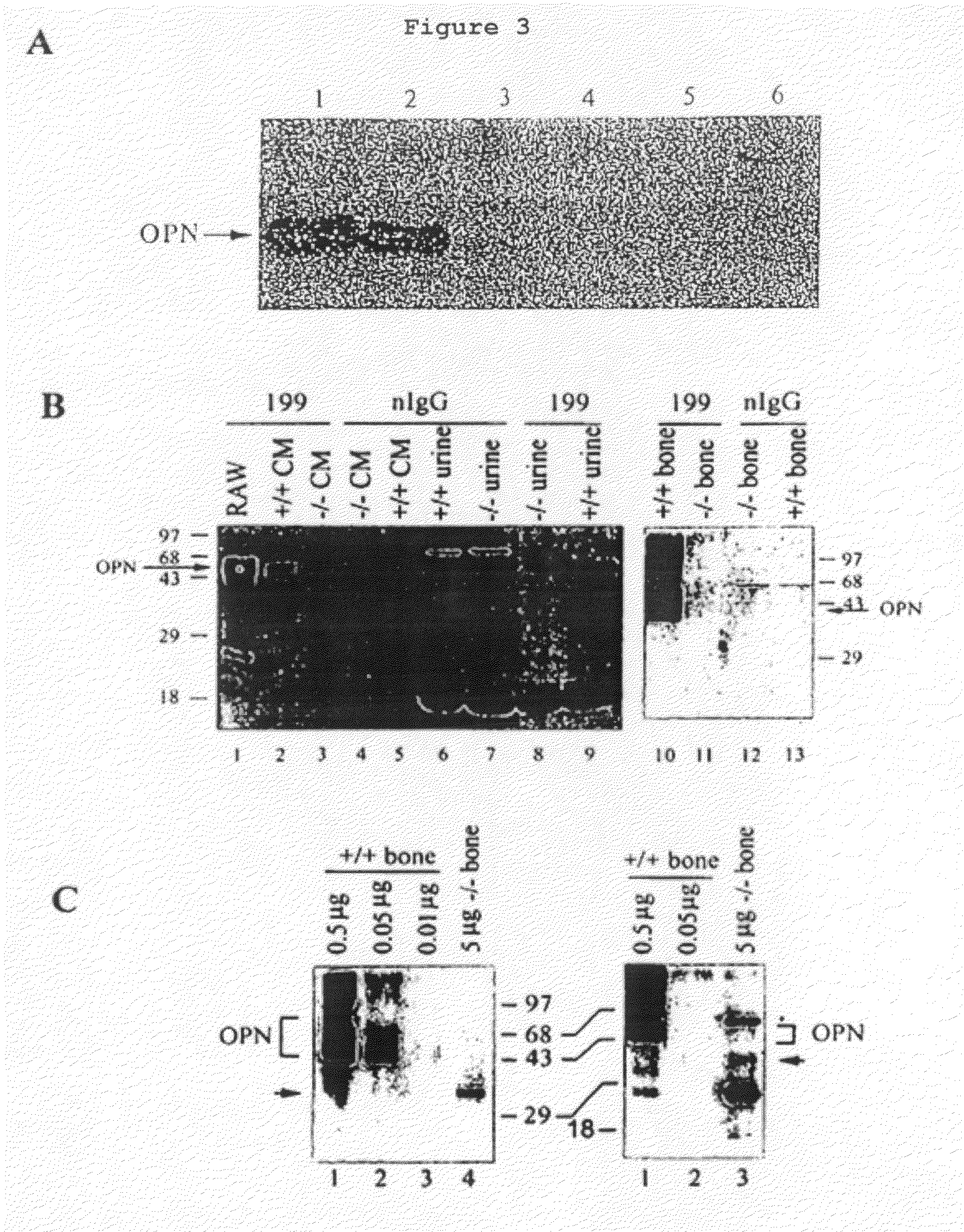Osteopontin Specific Antibodies and Methods of Use Thereof
a technology of osteopontin and specific antibodies, which is applied in the field of recombinant dna technology and transgenic animals, can solve the problems of unclear molecular mechanisms by which osteopontin effectuates these processes, and achieve the effect of inhibiting or promoting osteoporosis
- Summary
- Abstract
- Description
- Claims
- Application Information
AI Technical Summary
Benefits of technology
Problems solved by technology
Method used
Image
Examples
example i
Generation and Characterization of OPN− / − Knock Out Mice
[0075]Homologous recombination in embryonic stem cells has been utilized to generate mice with a targeted disruption of the osteopontin (Opn, or Spp1, for secreted phosphoprotein 1) gene. Mice homozygous for this disruption fail to express OPN as assessed at both the mRNA and protein level, although an N-terminal fragment of OPN is detectable at extremely low levels in the bones of − / − animals. The Opn− / − mice are fertile, their litter size is normal and they develop normally. The bones and teeth of animals not expressing OPN are morphologically normal at the level of light and electron microscopy, and the skeletal structure of young animals is normal as assessed by radiography. Ultrastructurally, proteinaceous structures normally rich in OPN, such as cement lines, persist in the bones of the Opn− / − animals. Osteoclastogenesis was assessed in vitro in co-cultures with a feeder layer of calvarial osteoblast cells from wildtype m...
example ii
Osteopontin Knockout Mice are Resistant to Ovarectomy-Induced Osteoporosis
[0093]As mentioned in the previous example, osteopontin is a ligand for the avb3 integrin, which is expressed at high levels in osteoclasts and has been implicated in the function and development of these cells. While osteopontin-deficient mice are fertile, develop normally, and exhibit no obvious defects in their mineralized tissues, these mice are resistant to ovariectomy-induced osteopenia. Thus, osteopontin is required for the rapid bone resorption resulting from the estrogen deficiency in ovariectomized mice. Accordingly, the osteopontin-deficient mice of the invention may be used to advantage to screen therapeutic agents that are involved in the development of osteoporosis. In one such assay, therapeutic agents would be administered to ovariectomized and non-ovariectomized osteopontin deficient mice. Agents which promote osteoporosis in the ovariectomized osteopontin deficient mice would then be characte...
example iii
Use of Osteopontin Knockout Mice for the Generation of Osteopontin Specific Monoclonal Antibodies
[0102]As mentioned in the previous examples, osteopontin is a widely expressed protein that has been conserved throughout evolution. The extensive similarity of osteopontin proteins among species presents certain problems for the generation of osteopontin-specific monoclonal antibodies. Antibodies are generated in response to exposure to foreign antigens. The foreign antigens must be recognized as “non-self” before an immune response will be mounted. The osteopontin knock out mice of the invention can be used to advantage for the production of osteopontin antibodies as these animals do not express native osteopontin. Antibodies so generated will provide a useful research tool for intracellular localizations, epitope mapping and immunoprecipitation studies for characterizing those proteins that form intracellular associations with osteopontin. This concept may also be expanded to encompas...
PUM
| Property | Measurement | Unit |
|---|---|---|
| Immunogenicity | aaaaa | aaaaa |
| Level | aaaaa | aaaaa |
Abstract
Description
Claims
Application Information
 Login to View More
Login to View More - R&D
- Intellectual Property
- Life Sciences
- Materials
- Tech Scout
- Unparalleled Data Quality
- Higher Quality Content
- 60% Fewer Hallucinations
Browse by: Latest US Patents, China's latest patents, Technical Efficacy Thesaurus, Application Domain, Technology Topic, Popular Technical Reports.
© 2025 PatSnap. All rights reserved.Legal|Privacy policy|Modern Slavery Act Transparency Statement|Sitemap|About US| Contact US: help@patsnap.com



